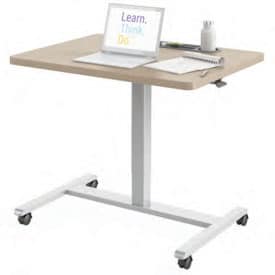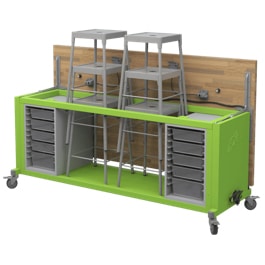For more than 70 years, the Haskell name has been synonymous with high quality furniture for the education market. We see Haskell products that were produced decades ago still serving schools in their everyday use. We are very proud of our heritage and the part Haskell has played in the world of education.
And yet, as we observed the rapidly changing landscape of education combined with dynamic shifts in curriculum, we saw an opportunity to challenge ourselves in the re-shaping of our company to better serve our core customers. The emergence of active learning environments in conjunction with powerful STEM/STEAM programs has generated new ways of thinking about the role furniture plays in the learning outcomes of today’s students.

With its dynamic height
range of 28.25 to 42 inches, Haskell’s award-winning Fuzion sit-to-stand desk is appropriate for schools pre-K to higher education.
Since 2014, we have designed and launched more than 25 new products specifically engineered for studentcentered learning. In 2019 we added education to our name, becoming Haskell Education. That same year, we launched our new website, haskelleducation.com, to better reflect our focus on the design of NextGen learning products. It has been a very exciting time for Haskell Education with tremendous growth and numerous awards for our product designs.
The design of these new products for schools provides us with a unique opportunity to respond to the educational, social and emotional needs of today’s learners. We believe that well-designed learning environments play an integral role in both the success of the educational process, and in driving greater student engagement. And when students are more engaged, learning outcomes improve.
Prevailing over constraints

A powerful mobile maker space – With six duplex outlets, four USB connections and an integrated power cord, the Rover™ Table can be quickly powered up for a full range of creative activities. Then unplug to transport it easily across the hall or across the district. It’s an ideal solution for a shared Maker curriculum.
A great example of this is our award-winning Rover™ Table. As part of our Explorer collection, the Rover™ Table was designed to bring the maker experience to the students instead of the other way around. Our paradigm up to that point was thinking of maker spaces as a static, dedicated environment. Teachers would need to schedule or reserve time for these spaces and students would “travel” to these rooms for a more immersive experience. And while there are numerous benefits to these types of spaces, we saw opportunities for improvement.
Through our research, we identified a number of constraints to dedicated maker spaces, the least of which was the reality that many schools simply do not have any extra space to dedicate to them. Successful maker programs typically require two things: large format tables where work can be spread out, and copious amounts of storage for all the necessary materials needed. Finding rooms large enough to accommodate these needs is difficult at best. But what if we could – by easily bringing these tools into the classroom – convert any space into a maker space?
The Rover™ Table was the solution, and schools have responded beyond our wildest imagination.
The brilliance behind the Rover™ Table is simple. Its design incorporates a large-format worktop (84 by 42 inches) that’s engineered to fit through a standard 30- or 36- inch door.
What’s more, when the butcher block worktop is flipped up and folded to the side of the table, there is room to tuck six stools in between two storage modules. That way, the entire ensemble can be easily transported by a single student or teacher from classroom to classroom. Or outdoors! Or into the gym! Or any place where maker activities are desired.
LEARN. THINK. DO.
Another constraint we saw was the sheer cost of setting up a dedicated maker space. For many schools, their budgets simply do not allow for these types of expenditures; denying students the real benefits of engaging in a maker program. With the Rover™ Table, schools can ramp up their maker programs at a much lower cost and, at the same time, extend the experience to a greater number of students. This creates equity on multiple levels while providing the opportunity for increased student engagement.
One of the biggest benefits of our research into the maker movement has been our deeper understanding of student engagement and current classroom design strategies. Our big “Aha!” moment came when we realized how extremely engaged students were while participating in maker activities … and how separating these activities away from the classroom had the potential to limit the powerful benefits that come with this level of engagement. We asked ourselves, why can’t learning, thinking and doing all happen in a harmonious way, in one environment, in the same space of time? We realized it could, and our classroom strategy of LEARN.THINK. DO. was born. It’s a powerful concept that is opening up doors at school districts across the country.
We would encourage anyone who is interested in more information around this strategy or any of our unique products to reach out to us at sales@haskelleducation.com.
Back to Insights










